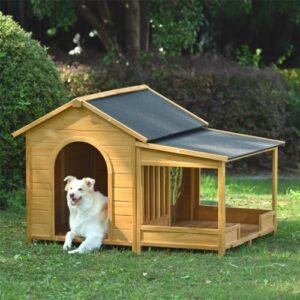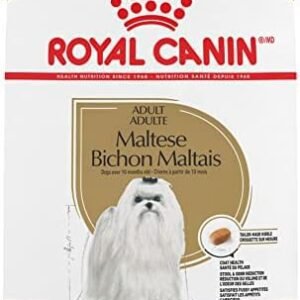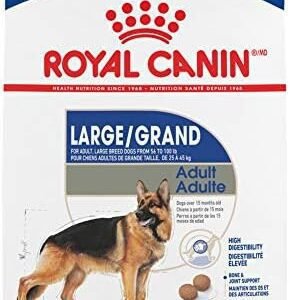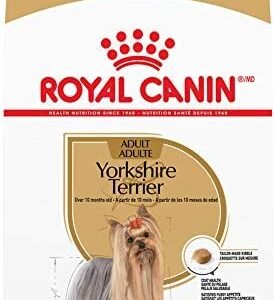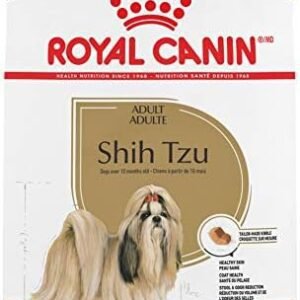Nearly 20% of dogs deal with anxiety at some point in their lives. Clonidine, once used mainly for humans, now helps dogs too. It’s gaining ground in treating anxiety and aggression in pets.
In this article, we uncover how clonidine can be used for dogs. We’ll look at the right dosage and the possible side effects. We will also see how it stacks up against other treatments.
Key Takeaways
- Clonidine is increasingly used in veterinary medicine for behavior management.
- This medication effectively addresses clonidine for dog anxiety and aggression.
- Proper clonidine dosage for dogs is crucial for efficacy and safety.
- Be aware of clonidine side effects in dogs to ensure prompt veterinary intervention.
- Understanding how clonidine works can help inform treatment decisions.
Table of Contents
Understanding Clonidine
Clonidine is a central alpha-2 agonist, known for its impact on the brain’s neurotransmitter release. Originally made for high blood pressure, it now helps with dogs’ behavioral issues too. Its calming effect makes it a popular choice for treating anxiety and stress in pets.
Clonidine for dogs is often given *off-label*. This means it’s used in ways not officially approved. Veterinarians must closely watch how dogs react to it. Since each dog is different, expert advice is key.
Dog owners must talk thoroughly with their vets about clonidine. Knowing the pros and cons helps create a custom treatment plan. It’s important to consider the dog’s health and behavior needs.
What is Clonidine for Dogs?
Clonidine is a medicine used mainly for treating specific behavioral issues in dogs. It’s known for its effectiveness against conditions like separation anxiety and noise fears. Even though it’s not officially approved for these uses, many vets recommend it for calming stressed dogs.
The drug comes in tablet and liquid form and is given by mouth. It’s often used together with other treatments for better results. Clonidine helps soothe anxious dogs and supports them in learning better behaviors, making it a useful tool for vets.
| Formulation | Administration Method | Common Uses |
|---|---|---|
| Tablets | Oral | Separation anxiety, noise phobias |
| Liquid | Oral | Supplemental therapy for anxiety disorders |
How Clonidine Works in Dogs
Clonidine works by blocking a key brain chemical linked to stress, known as norepinephrine. This leads to less anxiety in dogs dealing with stress. As a result, dogs feel calmer and more in control when facing scary situations.
Clonidine helps calm the body’s response to stress. This makes it a top choice for managing anxious behaviors in pets. Owners notice a big difference in their dogs’ demeanor. Treatments lead to lower heart rates and less blood pressure, making dogs more relaxed.
Giving clonidine at the right time boosts its effectiveness during fearful events. This approach not only reduces anxiety-driven actions but also helps dogs deal better with stress they used to fear.
Uses of Clonidine for Dogs
Clonidine helps dogs in many ways in the vet’s office. It mainly treats dog anxiety and helps manage aggression. This makes dogs feeling stressed feel better and stay calm. For dog aggression, it helps control strong reactions to other animals or new places.
Clonidine is also good for the stomach. It helps stop diarrhea and makes stool more solid. It’s useful for different health issues dogs may have. Vets even use it to help find certain diseases, like pheochromocytoma. This is a rare tumor in the adrenal glands.
Clonidine’s many uses show how important it is for dogs’ health and behavior. Knowing how it helps lets pet owners and vets make better health choices for dogs.
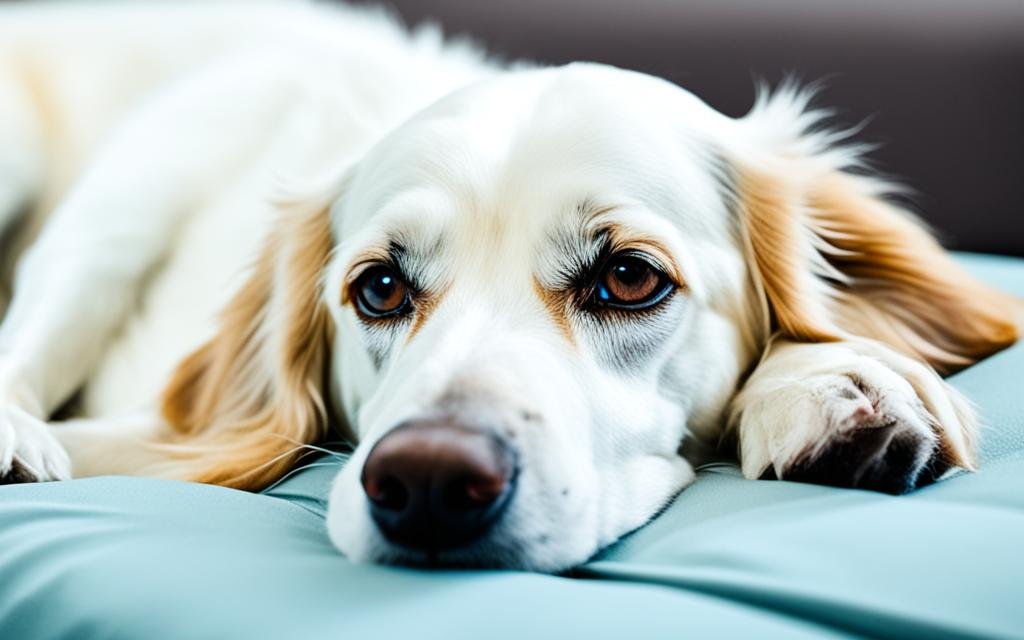
| Use of Clonidine | Description |
|---|---|
| Dog Anxiety | Reduces stress and helps calm dogs in anxious situations. |
| Dog Aggression | Moderates aggressive reactions during encounters with other animals or stimuli. |
| Diarrhea Control | Promotes stool solidity, improving gastrointestinal health. |
| Diagnostic Aid | Assists in diagnosing conditions like pheochromocytoma. |
Clonidine for Dog Anxiety
Clonidine is known to help with dog anxiety. Many owners see a big change for the better. They find it especially helpful alongside teaching their dogs new behaviors. Knowing what anxieties clonidine can treat helps owners make good choices for their distressed pets.
Types of Anxiety Treated
- Separation Anxiety: Clonidine can make dogs feel calmer when they’re alone.
- Noise Phobias: It helps lessen their fear during loud events like thunderstorms or fireworks.
- Travel Anxiety: Clonidine can also reduce stress from traveling or veterinary visits.
Behavior Modification
Using clonidine as part of a bigger plan is smart. It gives quick relief and allows time for learning new behaviors. Combining clonidine with behavior modification techniques can teach dogs how to deal better with their anxieties.
Getting to know what scares them and consistent training lead to a calmer dog. It’s wise for owners to work with vets. Together, they can create a plan that includes both medicine and behavior training.
| Type of Anxiety | Clonidine Benefit | Behavioral Strategy |
|---|---|---|
| Separation Anxiety | Reduces distress when alone | Gradual desensitization |
| Noise Phobias | Calms panic during storms | Positive reinforcement training |
| Travel Anxiety | Eases discomfort during trips | Conditioning and familiarization |
Clonidine for Dog Aggression
Dogs might act aggressively for different reasons, including fear, stress, and guarding their territory. It’s important to figure these out for help. Clonidine helps calm dogs and deal with anxiety that could make them aggressive. It’s part of a bigger plan to manage behavior, focusing on the cause and not just the signs.
Understanding Aggressive Behavior
Knowing what makes dogs act out is key for owners. Aggression comes from various sources:
- Fear and anxiety: Dogs sometimes get aggressive if they’re scared.
- Protective instincts: They may act out to protect their space from strangers.
- Frustration: Not enough space or friends can make them grumpy.
Clonidine helps dogs feel less anxious, which can make them less likely to become aggressive. When they’re calmer, training and behavior changes work better.
Dealing with aggression involves drugs, training, and changing the dog’s surroundings. Finding the root problem and using clonidine can improve the dog-owner bond.
Clonidine Dosage for Dogs
Finding the right clonidine dosage for dogs is key for its success. The needed dose can change based on each dog and what’s being treated. Always use a dosage chart to stay safe and effective.
Recommended Dosage Chart
| Weight (kg) | Starting Dose (mg) | Max Dose (mg) |
|---|---|---|
| 5 | 0.05 | 0.25 |
| 10 | 0.1 | 0.5 |
| 15 | 0.15 | 0.75 |
| 20 | 0.2 | 1.0 |
Frequency and Administration Guidelines
Clonidine is typically given to dogs every 12 to 24 hours. It can be for quick relief or long-term care. Always stick to what the vet says and keep doses timely for the best results.
Missed Dose Protocol
If you forget a dose, give it as soon as you remember. But if it’s almost time for the next one, skip it to avoid giving too much. Keeping a schedule is vital, especially for dogs with anxiety or behavior issues.
Clonidine Side Effects in Dogs
When you give your dog clonidine, it’s important to watch out for side effects. Knowing the clonidine side effects in dogs helps you take good care of your pet.
Common Side Effects
Some usual side effects in dogs include:
- Sedation
- Dry mouth
- Constipation
- Lethargy
These effects are mostly mild but keep an eye on your dog.
Serious Side Effects and Risks
Though rare, serious side effects can happen. These include:
- Hypotension (low blood pressure)
- Agitation or aggression
See a vet right away if your dog shows any serious signs.
Precautions for Pregnant/Lactating Dogs
Pregnant or nursing dogs need extra care. Clonidine can affect both milk and unborn puppies. A vet should check the risks and benefits first.
Potential Drug Interactions with Clonidine
Using Clonidine in dogs can lead to drug interactions needing careful attention. Medications like antihypertensives (enalapril, diltiazem) and some antidepressants (SSRIs, tricyclics) can affect Clonidine’s effectiveness. It’s important for dog owners to tell their vets about all drugs and supplements their pet takes. This information helps avoid negative reactions.
It’s good practice to check a dog’s health and blood pressure when they’re on Clonidine. Doing this helps catch any negative effects early. Vets are crucial in safely managing Clonidine treatment, ensuring dogs stay healthy.
| Drug Class | Examples | Potential Risk with Clonidine |
|---|---|---|
| Antihypertensives | Enalapril, Diltiazem | Increased blood pressure changes |
| Antidepressants | SSRIs, Tricyclics | Potential for increased sedation |
| Other Sedatives | Phenobarbital, Diazepam | Amplified central nervous system depression |
Benefits of Clonidine for Dogs
Clonidine helps dogs with anxiety in big ways. It works well for both quick fixes and long-term care. This helps dog owners know how to best care for their pet’s mental wellness.
Short-term Relief
Clonidine quickly helps dogs when they feel very stressed. During loud noises like thunder or fireworks, or scary visits to the vet, it helps calm them down. This lets dogs handle stress better right when it happens.
Long-term Management
Clonidine is also great for ongoing issues like separation anxiety. It helps dogs stay calm over time, teaching them to deal with what scares them. Dogs become more emotionally steady, making life happier for them and their humans.
| Benefit | Short-term Use | Long-term Use |
|---|---|---|
| Effectiveness | Rapid reduction of anxiety in stressful situations | Supports ongoing emotional regulation for chronic anxiety |
| Adjustment Period | Minimal; immediate effects noted | May require time for optimal results |
| Integration with Behavior Therapy | Can be used alongside short-term behavioral interventions | Enhances long-term behavior modification plans |
Clonidine Use in Dogs for Behavioral Conditions
Clonidine is used to help dogs with behavior issues. Vets often use it for problems like fear, too much activity, and too much barking. It is important to combine it with training to get the best results.
Clonidine can really help calm a dog’s anxiety. It changes how some brain chemicals work, helping reduce fear or aggression. This makes training more effective.
Here is a table that shows which behaviors clonidine can help with, including training tips:
| Behavioral Condition | Clonidine Use | Training Tips |
|---|---|---|
| Fear-based Aggression | Helps decrease anxiety and reactive behaviors. | Counter-conditioning exercises, gradual desensitization. |
| Excessive Barking | Reduces vocalization triggered by stress. | Positive reinforcement for quiet behavior. |
| Separation Anxiety | Provides calmness during separations. | Practice short absences, reward calmness. |
Comparison with Other Medications
When we look at behavioral medications for dogs, we find many choices, including clonidine. We will see how clonidine stacks up against other medicines like trazodone and SSRIs. We’ll look at how well they work and what they cost.
Efficacy of Clonidine vs. Common Alternatives
Clonidine helps dogs with anxiety, especially from certain triggers. Trazodone helps with relaxation, but clonidine might be better for anxiety. SSRIs are good for long-term anxiety care but are slow to start working. So, clonidine acts faster, but each dog’s needs can make a difference in choosing.
Cost Considerations
Cost matters a lot when picking between clonidine and other treatments. Clonidine is usually cheaper than many SSRIs, which can add up in cost. Trazodone’s price is similar to clonidine’s. But looking at costs long-term, clonidine could be more cost-effective. Knowing this helps pet owners make smart choices for their dog’s care.
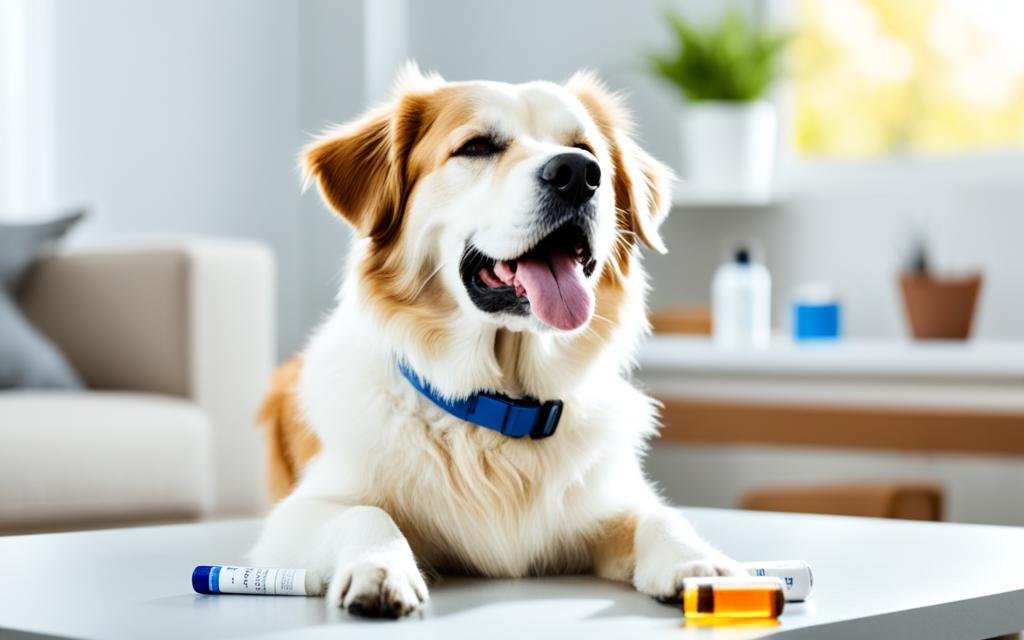
| Medication | Efficacy | Cost |
|---|---|---|
| Clonidine | Effective for anxiety, quick onset | Typically lower cost |
| Trazodone | Good for sedation, less effective for anxiety | Moderate cost |
| SSRIs | Long-term anxiety management, delayed effect | Higher cost |
Monitoring and Aftercare for Clonidine Treatment
It’s important to keep a close eye on dogs taking clonidine. Regular check-ups help spot any behavior changes or side effects. Side effects like sleepiness and low blood pressure need quick action.
Regular vet visits help check if the clonidine dose is right for the dog. The dose might change depending on how the dog is doing. This helps meet treatment goals safely.
Aftercare checks if other behavior treatments are working well with clonidine. Changes might be needed based on the dog’s progress.
- Watching for behavior changes.
- Keeping in touch with the vet about side effects.
- Making sure the clonidine dose is still right for the dog.
- Looking at other behavior treatments.
Following this plan can make your dog’s treatment work better. It leads to good results.
Veterinary Recommendations for Clonidine Use
Vets sometimes use clonidine for dogs with bad anxiety. This is when other treatments don’t work well. The drug helps with intense anxiety and aggression. But, a vet must always decide if it’s the right choice. Checking the pet’s health regularly is key to see if the medicine is working.
Following the vet’s advice on how much and when to give clonidine is critical. Each dog may need changes to their dose, depending on how they react and any side effects. Talking openly with the vet ensures clonidine is safe and effective for treating anxiety.
Safe Administration of Clonidine in Dogs
Giving clonidine to dogs should be done carefully, following vet advice. The dog’s health and other drugs it’s taking are important. Vets may suggest giving clonidine with or without food. This makes it easier for dog owners.
It’s crucial to store clonidine right to keep it working well. Keep it in a cool, dry spot away from light. This way, it stays effective and safe.
If you think your dog took too much clonidine, watch out for signs. These include being overly sleepy, weak, or having a slow heartbeat. If you see these, get emergency help right away. Catching these signs early is key to keeping your dog safe.
- Always follow what the vet says.
- Pick the best time for the medicine, thinking about whether to give it with food or not.
- Store the drug the right way to make sure it stays good.
- Be on the lookout for signs of too much medicine and know what to do in emergencies.
| Aspect | Recommendation |
|---|---|
| Dosage | As per veterinarian’s guidance |
| Administration | With or without food |
| Storage | Cool, dry place, away from light |
| Overdose Symptoms | Excessive sedation, lethargy, low heart rate |
Keeping clonidine safe for dogs ensures they get better without unnecessary risks.
Long-term Usage and Adjustment of Clonidine
When giving clonidine to dogs for behavior, it’s important to watch and change the dose as needed. Dogs may react differently over time. A vet’s regular check can catch side effects early. This ensures the treatment plan is always right for your dog.
Vets are key in guiding the long-term use of clonidine. They consider many factors when changing doses, such as:
- Changes in the dog’s weight
- Development of tolerance to the medication
- Presence of any adverse reactions
- Overall health status and concurrent conditions
Sometimes, the dose may need to go up or down to work best. Clonidine’s aim is to help dogs behave better without bad side effects. We also want to make their lives happier.
| Adjustment Factor | Recommended Action |
|---|---|
| Weight Increase | Consider increasing dosage |
| Developed Tolerance | Consult veterinarian for possible dosage adjustment |
| Adverse Reaction Present | Reevaluate treatment plan |
| Health Status Changes | Monitor and adjust as needed |
Working closely with your vet is very important. It keeps clonidine treatment for dog behavior both effective and safe. With regular checks, you can make changes before problems get worse. This helps a lot in taking care of your dog’s behavior issues.
Emergency Situations and Clonidine
If your dog is on clonidine and faces an emergency, acting fast can make a big difference. It’s important for owners to know the side effects of clonidine in dogs. Watch for signs like:
- Excessive sedation
- Lethargy
- Unusual behavioral changes
- Loss of coordination
If you think your dog has taken too much clonidine or is having bad side effects, get vet help right away. Knowing what signs to look for can help you act quickly. This might stop worse problems from happening. Also, talking to your vet can give you advice on what to do in these tough times.
Conclusion
Clonidine for dogs is a key solution for managing anxiety and aggression. For pet owners, knowing the right dosage of clonidine is very important. This knowledge ensures the treatment works well and lowers side effects.
Working together with vets, dog owners can make plans that fit their pets’ needs. This careful approach leads to better behavior and improves dogs’ wellbeing.
Understanding the side effects of clonidine in dogs is vital. With good advice and knowledge, pet owners can use this medication wisely. This creates a better life for their furry friends.




















